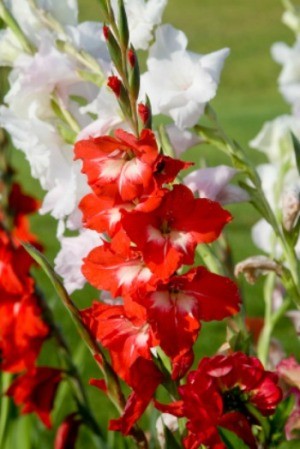 About the time roses and other perennials take a respite from mid-summer heat, summer bulbs step into the scene with an explosion of color. That's because unlike their spring-blooming cousins, summer bulbs are programed to thrive when temperatures rise. Here's what you need to get started growing them.
About the time roses and other perennials take a respite from mid-summer heat, summer bulbs step into the scene with an explosion of color. That's because unlike their spring-blooming cousins, summer bulbs are programed to thrive when temperatures rise. Here's what you need to get started growing them.
Tender bulbs are made up of a group of tropical and subtropical bulbs. None can withstand very cold temperatures, so depending on the severity of your winters, they will either need heavy protection, or you will need to dig them up at the end of each growing season and store them indoors. In the warmest climates (zones 9-11) tender bulbs can be grown as perennials. In most other climates they are either treated as annuals, or lifted in the fall and stored over winter.
The tender bulbs encompass a large group of plants, some of which are hardier than others. It's important to note that depending on where you garden, there may be a good deal of crossover between the classifications. A bulb considered tender in one growing zone may be considered hardy in another.
The general rule for planting bulbs is to plant them at a depth 3 to 4 times the height of the bulb. This will help to protect the bulbs against frost and (sometimes) foraging animals. Deeper planting also encourages stronger stems. A tubular bulb planter or narrow trowel is the best tool for the job. Simply stab the soil (or twist the planter), lift out the dirt, and place the bulb (pointed side up) in the bottom of the hole. Fill half of the hole with dirt, water lightly to settle the soil, and fill in the remainder of the hole. Firm the soil gently with your hands and water again.
Timing: The timing for bringing the bulbs in varies depending on individual species. Cannas and dahlias, for example, will tolerate some cold. Leave them in the garden until after the first frost. Tender species like tuberous begonias that cannot tolerate frost should be removed from the garden as soon as nighttime temperatures start dropping below 40 degrees F.
Markers: If the plant's foliage dies back before it is time to lift the bulbs it can be difficult to remember where you planted them. An easy way to remedy this is to surround your bulbs with a small piece of chicken wire at the time of planting. The wire will be easily hidden by growing foliage and reappear again as soon as it dies back.
Lifting: Use a trowel or spading fork to carefully lift your bulbs out of the soil. Trim back dead foliage to within 1/2 inch of the bulb and remove excess soil from around their roots with your fingers (or a gentle garden hose). Spread bulbs out on a newspaper in a shady spot to dry.
Storage: Once dry, loosely pack the bulbs in paper or mesh bags each labeled according to variety. Toss in a handful of slightly dampened peat moss to help prevent them from drying out. Store the bags in a cool, dark place for the winter, like a basement or garage. Temperatures between 45 and 55 degrees F degrees are ideal. Check the bags occasionally throughout the winter, adding moisture if necessary, and discarding any bulbs that show signs of shriveling or decay.
Here are the questions asked by community members. Read on to see the answers provided by the ThriftyFun community.
What bulbs produce flowers in the summer and fall? I think all mine are spring and early summer flowers, I just have a lot of green most of the summer and would love to add more flowers to my collection.
Kelly
"You don't stop laughing because you grow old.
You grow old because you stop laughing."
I wish people would add what zone they're in to better answer their questions! So, Kelly, what zone are you in?